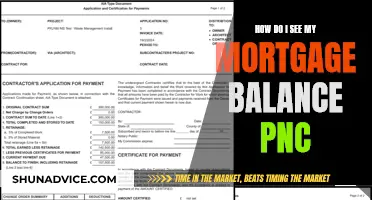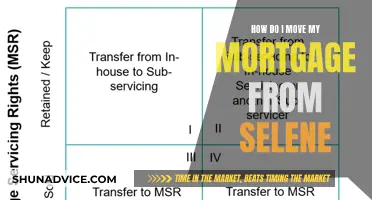
If you're a homeowner considering bankruptcy, you may be wondering whether to reaffirm your mortgage. Reaffirming your mortgage is a big decision that requires careful consideration of the pros and cons. A mortgage reaffirmation agreement is a legally binding contract between you and your creditor, where you voluntarily commit to repaying your mortgage debt, which would otherwise be discharged through bankruptcy. While reaffirming your mortgage may allow you to keep your home and improve your credit score, it also carries significant risks, as you remain personally liable for the debt. This means that if you fall behind on payments, your creditor can take legal action, such as foreclosing on your home or suing you for the remaining balance. Therefore, it's crucial to seek the advice of a bankruptcy attorney before making any decisions.
Reaffirming a Mortgage
| Characteristics | Values |
|---|---|
| Definition | A reaffirmation agreement is a new promise to repay a debt that would otherwise be wiped out in a Chapter 7 bankruptcy. |
| Benefits | Allows you to keep your home, improve your credit score, and maintain a positive relationship with your creditor. |
| Risks | If you cannot make your mortgage payments after reaffirming, you may lose your home to foreclosure and the mortgage company can sue you for money. |
| Requirements | A comprehensive multi-page reaffirmation agreement that must be filed with the court, court approval, and a bankruptcy attorney's indication that the agreement does not impose undue hardship on the client. |
| Considerations | Affordability of payments, the potential for modified mortgage terms, and the possibility of maintaining the relationship with the creditor. |
What You'll Learn

What is a mortgage reaffirmation agreement?
If you own a home and file for Chapter 7 bankruptcy, you may need to consider reaffirming your mortgage. Chapter 7 bankruptcy allows you to eliminate most of your debts and get a fresh start. However, it does not eliminate the lien on your property, and your lender can still use the mortgage to foreclose on your property if you don't make your payments. This is where mortgage reaffirmation comes in.
A mortgage reaffirmation agreement is a legally binding contract between a debtor and a creditor during a Chapter 7 bankruptcy proceeding. It allows the debtor to voluntarily commit to repaying a debt that would otherwise be discharged through the bankruptcy process. This type of agreement is typically used for secured debts, such as mortgages or car loans, where the debtor wishes to keep the collateral securing the loan. By signing a reaffirmation agreement, the debtor agrees to continue making payments under the original or modified loan terms, effectively removing that debt from the bankruptcy discharge.
It's important to note that reaffirming a mortgage debt is not a requirement and there may be no tangible benefit to doing so if your payments are current. You can keep your home even if you don't reaffirm your mortgage. You can continue making your mortgage payments after bankruptcy and protect your home from foreclosure, even without a reaffirmation agreement. However, if you do choose to reaffirm your mortgage, it may allow you to keep your home and improve your credit score by continuing to make payments on time.
Before signing a mortgage reaffirmation agreement, it is crucial to carefully weigh the pros and cons and seek the advice of a bankruptcy attorney. Some potential benefits of reaffirming a debt include preserving relationships with creditors and the potential for better loan terms. However, there are also risks involved, such as continued liability for the debt and the possibility of legal action if you fall behind on payments.
Making Mortgage Overpayments: A Guide to Getting Started
You may want to see also

Pros and cons of reaffirming your mortgage
Reaffirming your mortgage is a big decision that should not be taken lightly. It is essential to understand the potential benefits and drawbacks before making any choices. Here are some key pros and cons to consider:
Pros:
- Keep Your Home: Reaffirming your mortgage allows you to retain your home during bankruptcy. Without reaffirmation, you could lose your house if you cannot make the payments.
- Improved Credit Score: Continuing to make timely payments on your reaffirmed mortgage can help rebuild and improve your credit score. This could be beneficial if you wish to take out future loans or mortgages.
- Maintain Positive Relationships with Creditors: Reaffirming your mortgage can help maintain a positive relationship with your creditor. This could be advantageous if you want to do business with them again in the future.
- Potential for Modified Loan Terms: Reaffirming your mortgage may lead to modified loan terms that are more favourable, such as a lower interest rate or lower monthly payments.
Cons:
- Financial Risk: Reaffirming your mortgage can be risky, especially if your financial situation is uncertain or takes a turn for the worse in the future. If you fall behind on payments, the creditor can take legal action, such as repossession or suing for the remaining balance.
- Continued Liability: Once you reaffirm your mortgage, you are legally obligated to continue making payments. This continued liability means that you remain responsible for the debt even after bankruptcy.
- Potential for Negative Consequences: While reaffirmation may help in some cases, it is not always beneficial. In some instances, it may lead to negative consequences, such as foreclosure and legal judgments if you default on the loan.
- Unnecessary in Many Cases: It is important to note that reaffirmation agreements are often unnecessary. You can usually keep your home and continue making payments without reaffirming your mortgage.
- No Guarantee of Benefits: Reaffirming your mortgage does not always lead to improved credit reporting or better loan terms. Some lenders may not offer any additional benefits, and there is a chance that your financial situation could change for the worse.
Before making any decisions, it is crucial to carefully weigh these pros and cons and seek the advice of a bankruptcy attorney or financial expert. They can provide personalised guidance based on your unique circumstances.
Exploring Options: Strategies to Temporarily Pause Mortgage Payments
You may want to see also

Bankruptcy and mortgage reaffirmation
If you own a home and file for Chapter 7 bankruptcy, mortgage reaffirmation may be an option. Chapter 7 bankruptcy allows you to eliminate most of your debts and get a fresh start. However, it does not eliminate the lien on your property, and your lender can still foreclose on your home if you don't make your mortgage payments.
A reaffirmation agreement is a legally binding contract between a debtor and a creditor during a Chapter 7 bankruptcy proceeding. It allows the debtor to voluntarily commit to repaying a specific debt, such as a mortgage or car loan, that would otherwise be discharged through the bankruptcy process. By signing a reaffirmation agreement, you agree to continue making payments under the original or modified loan terms and keep the property.
Reaffirming your mortgage can have both positive and negative consequences. On the positive side, it may allow you to keep your home and improve your credit score by continuing to make payments on the mortgage. It can also help maintain a positive relationship with your creditor, which could be beneficial for future business.
However, reaffirming your mortgage also has its risks. If you cannot make your mortgage payments after reaffirming the debt, you may lose your home to foreclosure. Additionally, if you fall behind on payments, the creditor can take legal action, such as repossessing the property or suing for the remaining balance. It's important to carefully weigh the pros and cons and seek the advice of a bankruptcy attorney before making any decisions.
Solo Mortgage Applications: A Comprehensive Guide
You may want to see also

How to reaffirm your mortgage
Reaffirming your mortgage is a big decision that requires careful consideration. Here are the steps and factors to consider when thinking about how to reaffirm your mortgage:
Understanding Reaffirmation Agreements
Reaffirmation agreements are legally binding contracts between debtors and creditors during Chapter 7 bankruptcy proceedings. These agreements allow debtors to voluntarily commit to repaying specific secured debts, such as mortgages or car loans, that would otherwise be discharged through bankruptcy. By signing a reaffirmation agreement, you agree to continue making payments under the original or modified loan terms, effectively removing that debt from the bankruptcy discharge. It's important to note that reaffirmation agreements are not necessary for mortgages, and you can keep your home even without signing one.
Weighing the Pros and Cons
Reaffirming your mortgage can have both positive and negative consequences. On the positive side, reaffirming may allow you to keep your home and improve your credit score by continuing to make timely payments. It can also help maintain a positive relationship with your creditor, which could be beneficial for future loans or mortgages. However, reaffirming your mortgage debt carries significant risks. If you fall behind on payments, you may face foreclosure and be personally liable for any remaining balance, which could result in aggressive collection actions, wage garnishment, or seizure of property. Additionally, some bankruptcy attorneys may advise against signing reaffirmation agreements, especially if they believe it will impose a financial hardship on their clients.
Seeking Legal Advice
Before making any decisions, it is crucial to seek the advice of a bankruptcy attorney. They can help you understand the legal implications, review any reaffirmation agreement you receive, and determine if reaffirming your mortgage is in your best interest. Remember that judges' stances on reaffirmation agreements may vary depending on the state, so consulting a local bankruptcy lawyer familiar with the laws in your area is essential.
Understanding Modified Terms
In some cases, reaffirming your mortgage may be beneficial if the mortgagee agrees to modify specific terms to make the loan more favourable for you. This could include lowering the interest rate, reducing the monthly payment amount, or making other adjustments that could provide financial relief. Carefully review any proposed modifications to ensure they align with your financial goals and abilities.
Assessing Financial Capability
Finally, reaffirming your mortgage means making a new promise to repay the debt and committing to timely payments. It is essential to assess your financial situation and be confident that you can afford the payments. Consider your income, expenses, and overall financial stability to ensure that reaffirming your mortgage is a realistic and sustainable decision.
Making Woolwich Mortgage Overpayments: A Step-by-Step Guide
You may want to see also

When to seek legal advice
If you are considering reaffirming your mortgage, it is highly recommended that you seek the advice of a bankruptcy attorney. Reaffirming your mortgage can be complex and challenging, and it is only suitable for some. It is crucial to carefully weigh the pros and cons and understand the consequences.
Firstly, you should consider whether you can afford the payments. Reaffirming your mortgage means making a new promise to repay the debt and committing to making your payments on time. You should also consider whether you want to keep the property in the long term. If you are unsure, it may be best to avoid reaffirming the mortgage.
You should also consider whether there are other options for dealing with the debt. For example, in some cases, debtors may choose not to reaffirm but rather "redeem" the property by paying the creditor a lump sum to settle the debt. Another option is to “surrender” the asset if keeping it is not financially feasible.
It is important to remember that reaffirming a debt in bankruptcy means that you continue to be obligated on the debt as if you hadn't sought bankruptcy protection. Debtors do not have to reaffirm a mortgage debt, and there is generally no reason to do so unless the mortgagee has agreed to modify one or more of the mortgage terms to make keeping the mortgage more beneficial.
Finally, you should be aware that if you reaffirm the mortgage and cannot make the payments, the mortgage company can and likely will sue you for the money. They cannot sue you for money if you refuse to reaffirm.
Proving Your Mortgage Payment: Documenting Your Final Payment
You may want to see also
Frequently asked questions
A mortgage reaffirmation agreement is a legally binding contract between a debtor and a creditor during a Chapter 7 bankruptcy proceeding. It allows the debtor to voluntarily commit to repaying a debt that would otherwise be discharged through the bankruptcy process.
Reaffirming your mortgage can help you maintain a positive relationship with your creditor and may allow you to keep your home and improve your credit score. However, if you cannot make your mortgage payments after reaffirming the debt, you may lose your home to foreclosure, and the mortgage company can sue you for the remaining balance.
To reaffirm your mortgage, you will need to sign a reaffirmation agreement with your creditor, which must be filed with the court. The agreement will require court approval to ensure that you can afford to continue making payments. It is important to carefully consider the potential risks and benefits of reaffirming your mortgage and, if necessary, seek the advice of a bankruptcy attorney.







